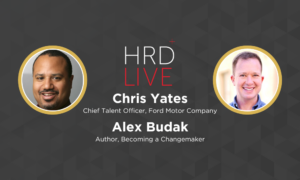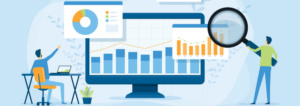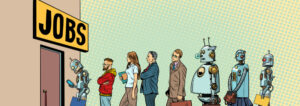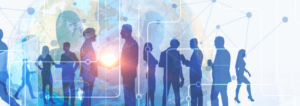Q&A: Siemens on surviving uncertainty and fast paced change
- 9 Min Read
The future of work in the emerging digital ecosystem has been a topic of increasing interest as organisations try and keep up with rapid developments. Siemens understands that true digital transformation is more than just putting technology in place, Director of HR for Siemens UK and Northern Europe, Toby Peyton-Jones, joined HRD Connect to talk […]
- Author: Unzela Khan
- Date published: Jun 28, 2017
- Categories

The future of work in the emerging digital ecosystem has been a topic of increasing interest as organisations try and keep up with rapid developments.
Siemens understands that true digital transformation is more than just putting technology in place, Director of HR for Siemens UK and Northern Europe, Toby Peyton-Jones, joined HRD Connect to talk about the ecological mindset, leadership culture and adapting to the new digital reality.
When you joined us in Birmingham this February, you outlined the necessity of preparing our mindsets for a different world. The ecological mindset which deals with complexity, interconnectedness and too much data, you suggested is one that will allow us to co-create our future. How do we as HR leaders help root this mindset within our organisations?
“Like everything, the mindset is based on people really understanding why we need to change. People talk a lot about the need to change, of course that is important, but sharing the understanding about ‘why’ is probably one of the most important steps in shifting the mind set.
I think sometimes people are too close to their own particular discipline. While they know that this new digital disruptive world is hurtling towards them they don’t recognise the overall implications, not just for them, but for the business model they play a part in and for the way they are working. One of the key roles of a leader, whether in HR or as a CEO is to join the dots for people and bring together that over arching picture and to start the conversation about what that means for us. It is that conversation that will plant the seed of a new mind set.
There are many aspects of this change narrative but one key ingredient is reaching a tipping point in the rate of change and complexity, driven by the exponential rate of data production and computing power. This shift, from the old certainties, to the new world, is stark. In the old world there was too little data and the role of leaders in companies and students in class rooms was to provide answers. In the new world, a world connected globally and flooded with data, asking smart questions and iterating our way towards solutions becomes an essential strategy to deal with the volatile mix of risk and opportunity. Our iconic visionary leader has been schooled in spotting the big opportunity, aligning everyone to it, and their big forehand slam is execution. That way of leading becomes a huge problem in the new world, where harnessing the collective intelligence of the whole organisation and beyond is so key to survival. In this scenario the visionary leader will probably be the most dangerous person in the room and so the whole leadership culture needs to change”.
What kind of leadership will enable this culture?
“Well we will still need inspiring leaders, but instead of them spotting that big opportunity they will be reaching out to people in and beyond their organisation to join them in a field of endeavour. Instead of aligning people and squashing descent they will be encouraging diversity of thinking and ideas, their insight will show itself in listening, asking smart questions, and joining the debate. They will enable the organization and be at the centre of an ecosystem not at the top. It’s a profound change that makes use of the huge connectedness that goes well beyond the organisational boundary and means that not only leaders but everyone will need to develop new ways of working and new skill sets to survive”.
For the HR Director, who has been more reactive to digital disruption, how do they start thinking about the future of work in the emerging digital ecosystem?
“I guess a good place to start looking at the future of work is to begin by examining our existing work practices and the new world that’s emerging and see where there are trends already hitting the work place.
We have talked about leadership so let’s take a different aspect: One such trend is computing power and the impact on the automation of professional roles and tasks.
The big game changer here is computers that learn, and learn like children. In the past computers had to learn like adults learning a new language, they needed programming with all the rules and situations that they might face and it was slow going with variable results. Today with the exponential growth in computing power computers learn like children. Kids don’t learn grammar to learn to speak fluently they just work it out as they go along and the latest computers learn in the same way but they learn many times faster than a human. That is why companies like Siemens can already demonstrate things like driverless car technology, a task that we could never have imagined a computer could do, or computers that can diagnose cancer cells in scans more accurately that a doctor trained for 20 years in oncology.
Estimates show that up to 60% of professional jobs could be subject to automation so in HR we need to lead that conversation and start answering the next question which is what skills and capabilities will not be automated. What new roles will open up as a result of digitalisation? Research suggests that 60% of jobs that millennial will move into don’t exist yet”.
Having built a picture of the culture change needed to respond to this newly emerging digital ecosystem, can you tell us a little bit more about the journey Siemens have been through in developing this out?
“The first thing to say is that this is going to be a journey that does not end. To say we’ve got all the answers would be completely wrong but there are some definite start points.
We identified that changing the culture had to be central to our ability to address all of the other issues that we have talked about but this is a big ask, and easier said than done.
Siemens is an engineering company, it understands machines and processes and the way we would normally go about a challenge like this would be to map the ‘as is’ culture, then map the ‘to be’ culture and set up a project with work streams KPI’s and road maps. We would prepare a slide deck of maybe 200 slides and off we go!
It’s quite comical really, but one of our early learnings and one that seems obvious when pointed out, is that you can’t change to the new culture using the old culture. Just recognising this provided us with a start point for our approach.
So that was one of our first big challenges. How could we harness the new ways of working that donor yet exist to help us change to that new culture. That meant a recognition that we were not going to impose something, we were going to co-create the new culture in an agile, viral and adaptive way.
The way we went about this was to start a set of conversations introduced by our CEO who talked about the central importance of ‘Ownership Culture’ that enables everyone to act as if it were their own company. It is a simple idea, but embedded in it are many more conversations, for example one dilemma it implies is we are a large company, but how can we enable everyone to feel they have the empowerment of a small company? These dilemmas and conversations have spread out across our company of over 300 thousand employees around the globe.
Many things became clear when we engaged our employees at all levels in this way. Our over reliance on processes slowed us down and dis-empowered our people and did not deliver any value. We have seen town hall meetings, which even with Q&A ended up more Q than A now turned round to become listening groups, where the dilemmas and challenges were unpacked together. Co-creation workshops with customers, hackathons and scrum sessions became more the norm and leaders had to be trained in new skill sets as employees started to push at the boundaries of what was is now possible.
It is a work in progress that every day throws up new things but at the heart of it is an ‘adaptive conversation methodology’ that changes the leadership narrative and catalyses a set of sometimes very unexpected innovations.”
It would be great to have a real-life example of how adapting to this new digital reality and mastering this complex world, Siemens have used disruption to develop a specific competitive advantage?
“I could talk about a number of examples, there are a whole range of case-studies from the micro to the macro, but let me talk about one that I think brings about one of the biggest advantages. Siemens has about 20 inventions a day, almost one an hour. Not all of those are patented and not all of those that are then patented turn into products, but the proportion of inventions to the number that are now co-created through crowd sourcing or with customers, suppliers or universities has radically changed from internal to external.
Our network of innovation that used to be done in our R&D departments has not only now spread throughout the whole company, but also into the businesses and social communities in which we live and the learning institutions that support them.
So at Siemens in Lincoln for instance, where we make gas turbines, the engineering faculty from Lincoln University can often be found in our factory and conversely our managers can be found in the University working with customers on test rigs that are also used by our apprentices. It’s an ecosystem of learning and innovation that not only spreads out into the local society but also reaches out globally.
For instance, our Product Life Cycle software enables teams around the world who are involved the complete engineering value chain to collaborate and innovate in real time. They use our Siemens PLM software in some of the Formula 1 teams. If you need to make a new car every race and have it ready to go in a different part of the world that is quite a challenge. The software enables that but you also need that culture of collaboration and innovation that we have talked so much about. It is a brave new world and it is great to be part of shaping it”.









